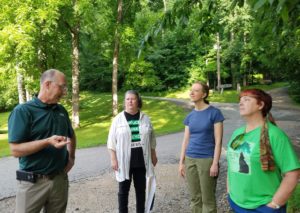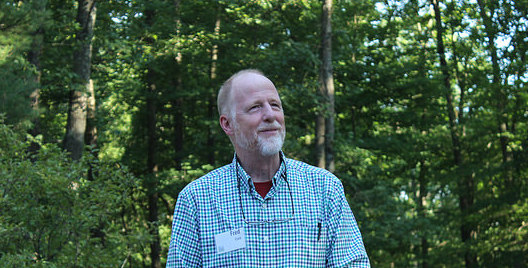Last month, Wisconsin-based forester and forest ecologist Fred Clark visited Indiana to dialogue with legislators, DNR leadership, and IFA staff, at the invitation of Executive Director Jeff Stant. Fred brought a unique viewpoint. His 35-year career as a natural resources professional includes leading the Forest Steward’s Guild, a national organization dedicated to sustainable forest management. Fred also served three terms as a state representative in Wisconsin’s state legislature, sitting on governor-appointed forestry committees. And he runs Clark Forestry, Inc., managing public and private forestland throughout Wisconsin, and offering timber management, custom logging, and reforestation services.
IFA is not categorically opposed to foresters or forest management. We simply believe that taxpayers should have a voice in how public forests are managed. And we’re inspired by Wisconsin’s public input process, described by Fred below. Let’s work with DNR to enact this in Indiana!
by Fred Clark
I enjoyed spending a few days last week learning about the Indiana Forest Alliance and about the management of state forest lands in Indiana. Along with Jeff Stant and IFA Conservation Director Rae Schnapp, we’ve met with legislators and with staff from the Division of Forestry. I certainly learned a lot!
As a forester, ecologist, and former legislator in Wisconsin, I’ve tried to offer another perspective on Indiana forest issues. We expect our public forests to produce a variety of benefits for citizens, and forest managers must play a critical role in satisfying multiple uses while keeping forests healthy and resilient. As the impacts of climate change and invasive species increasingly affect our forests, that work becomes even more important and more challenging.
 There is a role for active forest management, including timber harvesting, on public forest lands. Active forest management can include a wide range of activities and intensity, ranging from areas subject to clearcutting to areas where no management occurs (passive management). It’s critically important, however, to work hard to balance timber management and other values by protecting sensitive and unique areas, and employing a range of management intensity in other areas. Good forestry fits the activities to unique aspects of each site, instead of forcing the same activity on every acre.
There is a role for active forest management, including timber harvesting, on public forest lands. Active forest management can include a wide range of activities and intensity, ranging from areas subject to clearcutting to areas where no management occurs (passive management). It’s critically important, however, to work hard to balance timber management and other values by protecting sensitive and unique areas, and employing a range of management intensity in other areas. Good forestry fits the activities to unique aspects of each site, instead of forcing the same activity on every acre.
In Wisconsin, management on our state forests is driven by comprehensive master plans that are developed for each forest following an extensive process of public input and collaboration with other resource experts. The resulting plans create land use priorities for each forest and provide a picture of the goals and activities that will occur over time. While stakeholders may not get everything they wanted in a good master plan, most will support an outcome that results from a truly inclusive process. We have not had many controversies over forest management in Wisconsin for a long time, and I think our commitment to collaborative planning is part of the reason why.
Our public forests are essential assets for recreation, wildlife, clean water, cool and clean air, carbon storage, and forest products. These benefits may not occur on every acre, but they can all occur on well-managed public forest lands. While there may be areas of specific disagreement, I believe that the staff of the Indiana DNR Division of Forestry work hard to balance many competing interests and maintain healthy, productive state forests.
As the Indiana Forest Alliance calls attention to the importance of protecting Indiana’s highest quality forests, there is much room for working together to achieve goals that we should all share to protect forests for future generations.

